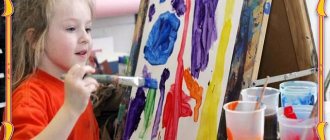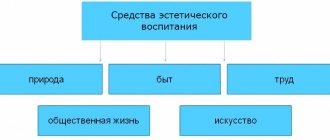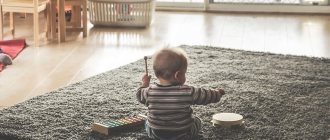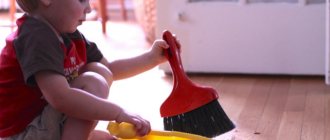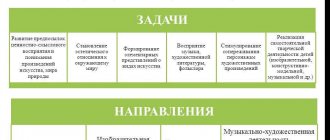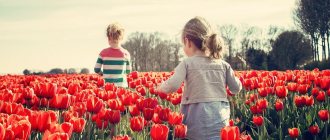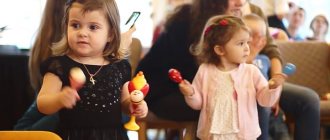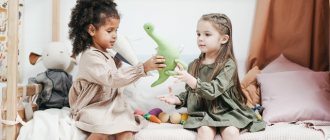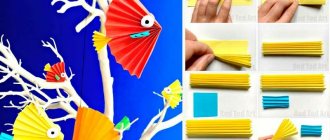The bright colors of nature and pleasant sounds attract the attention of children and thereby evoke emotions, have a positive effect on the development of perception, imagination and stimulate creative activity.
Observation and imagination are important for the aesthetic perception of nature. Children describe this beauty at their own level and express their emotions and feelings in their own way. At the first educational stage, these feelings will be simple, but it is important that the child can see, feel this beauty and experience it emotionally. For a holistic perception, you can add literary works about nature.
Labor activity
An important tool in the education of aesthetics is work. Mental and physical labor actively influence the aesthetic development of students. This happens through the labor process, the content of labor and its results, as well as the emerging relationships in the process of labor activity. The aesthetic feeling in pupils is evoked by such elements of work as rhythm, tempo, proportion, harmony. The aesthetic sense is manifested in the ability to see beauty in creative work, to receive joy from participating in work activities, and to create an aesthetic environment for such activities. Properly organized work generates a feeling of satisfaction and pleasure.
You can avoid turning work into a burden and a burden by endowing it with a socially significant goal, planning and saving time, inspiration, and passion.
Artistic and aesthetic development of children of senior preschool age
Ekaterina Klenova
Artistic and aesthetic development of children of senior preschool age
«Artistic and aesthetic development of children of senior preschool age.»
In recent years, has increased to the problems of the theory and practice of aesthetic education as the most important means of forming an attitude towards reality, a means of moral and mental education, as a means of forming a comprehensively developed , spiritually rich personality.
R. Tagore said: “You cannot raise a full-fledged person without instilling in him a sense of beauty.” These words simply and clearly express the idea of the indissolubility of moral and aesthetic education, the connection between aesthetic ideals and the understanding of beauty as the measure of all things. Visual activity is of great importance in solving the problems of aesthetic education, since by its nature it is an artistic activity . The specific nature of visual arts classes provides ample opportunities for experiencing beauty and for developing children’s emotional and aesthetic attitude to reality.
Each type of visual activity, in addition to the general aesthetic influence, has its own specific effect on the child. The application is of great importance for the training and education of preschool children . It contributes to the formation and development of many personal qualities of an individual, his mental and aesthetic capabilities.
Modern pedagogical and psychological research proves the need for visual arts classes for the mental and aesthetic development of children in preschool age . The importance of appliqué classes, including the use of non-traditional techniques, using entertaining material for the education of preschoolers , has been historically and scientifically proven. As a result of generalizing the experience of teachers, the importance of appliqué training was revealed:
— development of aesthetic worldview, education of artistic taste ;
1. development of artistic and graphic skills;
2. development of fantasy , creative thinking and imagination, spatial perception;
3. development of precise hand movements and fine motor skills of the fingers;
4. the formation of some organizational skills of artistic creativity ;
5. obtaining information about domestic and world artistic culture ;
6. education of spectator culture;
7. possible disclosure of the beginnings of professional artistic and visual activity.
The problem of aesthetic education is of interest to specialists in various fields: educators, teachers, psychologists. After all, deep aesthetic feelings, the ability to perceive beauty in the surrounding reality and in art are an important condition for a person’s spiritual life.
Specialists in preschool education (L. Schleger, V. Schmidt, D. Lazutkina, E. Tikheyeva, R. Orlova, A. Surovtseva) and figures in general psychology, pedagogy, physiology ( S. Shatsky, P. Blonsky, E. Arkhin, K. Kornilov, etc.)
.
Currently, the high social significance of the topic forces us to take a different look at the issues of education and training in kindergarten, at the relevance and need for developing developmental classes in aesthetic education.
The relevance of the chosen topic is determined by the fact that in order to effectively carry out the work on aesthetic education of children of middle preschool age through paper appliqué, it is necessary to develop a set of classes aimed at education, “clarification”
feelings of a small person,
development of the ability to distinguish shades of color and sound, a feeling of unity with nature.
In classes, a combination of transferring new information with its use and consolidation in practical activities should be used. Since this problem is relevant, the topic of this course work is “Paper application in classes with children of senior preschool age .”
The subject is the process of implementing aesthetic education for children of senior preschool age in appliqué classes.
The object is the aesthetic education of children of senior preschool age through application.
The purpose of the study is to determine the most effective ways and methods of aesthetic education of children of senior preschool age through application.
Hypothesis – we assume that application classes will be successful under the following conditions:
- if appropriate materials are available;
- if the teacher is well prepared;
- if there is a favorable psychological environment;
- if children have appropriate motivation.
Based on the goal, it is necessary to solve the following tasks:
- to reveal the essence and content of application classes with children of senior preschool age ;
— introduce means and methods for developing in children the knowledge , skills and abilities necessary in classes on paper appliqué;
— to study the role of motive in the aesthetic education of children of senior preschool age
Theoretical foundations of teaching paper applications to children of senior preschool age
The essence of aesthetic education
The ideas of aesthetic education originated in ancient times.
Ideas about the essence of aesthetic education, its tasks, and goals have changed, starting from the times of Plato and Aristotle right up to the present day. These changes in views were due to the development of aesthetics as a science and understanding of the essence of its subject. The term "aesthetics" comes from the Greek "aisteticos" (perceived by the senses)
.
Materialist philosophers (D. Diderot and N. G. Chernyshevsky)
believed that the object of aesthetics as a science is the beautiful. This category formed the basis of the aesthetic education system.
In a brief dictionary on aesthetics, aesthetic education is defined as “a system of activities aimed at developing and improving a person’s ability to perceive, correctly understand, appreciate and create the beautiful and sublime in life and art.” In both definitions, we are talking about the fact that aesthetic education should develop and improve in a person the ability to perceive beauty in art and in life, to correctly understand and evaluate it. The first definition, unfortunately, misses the active or creative side of aesthetic education, and the second definition emphasizes that aesthetic education should not be limited only to a contemplative task, it should also form the ability to create beauty in art and life.
D. B. Likhachev in his book “The Theory of Aesthetic Education of Schoolchildren” relies on the definition given by K. Marx: “Aesthetic education is a purposeful process of forming a creatively active personality of a child, capable of perceiving and appreciating the beautiful, tragic, comic, ugly in life and art , live and create “according to the laws of beauty.” The author emphasizes the leading role of targeted pedagogical influence in the aesthetic development of a child. For example, the development of a child’s aesthetic attitude towards reality and art, as well as the development of his intellect , is possible as an uncontrolled, elemental and spontaneous process. Communicating with the aesthetic phenomena of life and art, the child, one way or another, develops . But at the same time, the child is not aware of the aesthetic essence of objects, and development is often determined by the desire for entertainment ; moreover, without outside intervention, the child may develop incorrect ideas about life, values, and ideals. B. T Likhachev, as well as many other teachers and psychologists, believes that only targeted pedagogical aesthetic and educational influence, involving children in a variety of artistic and creative activities can develop their sensory sphere , provide a deep understanding of aesthetic phenomena, and raise them to an understanding of true art, the beauty of reality and beauty in the human personality (17; 42)
.
The creativity of a preschooler has its own characteristics.
Children make many discoveries and create an interesting, sometimes original product in the form of a drawing, design, poem, etc. (E. A. Florina, G. V. Labunskaya, M. P. Sakulina, K. I. Chukovsky, J. Rodari, N. A. Vetlugina, N. N. Poddyakov, etc.). The novelty of discoveries and products is subjective; this is the first important feature of children's creativity.
At the same time, the process of creating a product for a preschooler is almost of paramount importance. The child’s activity is characterized by great emotional involvement, the desire to seek and try different solutions many times, receiving special pleasure from this, sometimes much more than from achieving the final result. The creativity of a preschooler has its own characteristics.
Children make many discoveries and create an interesting, sometimes original product in the form of a drawing, design, poem, etc. (E. A. Florina, G. V. Labunskaya, M. P. Sakulina, K. I. Chukovsky, J. Rodari, N. A. Vetlugina, N. N. Poddyakov, etc.). The novelty of discoveries and products is subjective; this is the first important feature of children's creativity.
At the same time, the process of creating a product for a preschooler is almost of paramount importance. The child’s activity is characterized by great emotional involvement, the desire to seek and try different solutions many times, receiving special pleasure from this, sometimes much more than from achieving the final result (A. V. Zaporozhets, N. N. Poddyakov, L. A. Paramonova, O. A. Christ and others). And this is the second feature of children's creativity.
For an adult, the beginning of solving a problem (its awareness, search for approaches)
is the most difficult and painful, sometimes leading to despair.
A child, unlike an adult, does not experience such difficulties (unless, of course, he is subject to the strict demands of adults)
.
He easily and, above all, practically begins indicative, sometimes not even entirely meaningful, activity, which, gradually becoming more purposeful, captivates the child with the search and often leads to positive results (N. N. Poddyakov, L. A. Paramonova, G. V. Uradovskikh)
.
And even in a child’s musical creativity, there is a simultaneity of composing and performing (K. V. Tarasova)
. And this is the third feature of children's creativity, certainly related to the first two and especially to the second.
The above features of children's creativity demonstrate a certain degree of imperfection of the child's mental processes, which is natural at this age . And taking into account these features is necessary in organizing developmental education for children .
Creative development of preschool children .
The development of personality and its achievements along the path of life are closely related to such individual psychological characteristics of a person as abilities, inclinations, and talents. Childhood is a period of intense development , change and learning, paradoxes and contradictions, without which it is impossible to imagine the process of personality formation. This is most clearly expressed in creative activity, which allows one to reveal one’s inner world especially fully.
Creativity is increasingly viewed as the most meaningful form of mental activity, a universal ability that ensures the successful implementation of a wide variety of activities.
Preschool age is a favorable period for the development of creativity . It is at this time that progressive changes occur in many areas, mental processes (attention, memory, perception, thinking, speech, imagination) are improved, personal qualities are actively developing , and on their basis - abilities and inclinations.
Preschool childhood becomes a turning point in the development of attention , when children first begin to consciously control it, directing and holding it on certain objects. For this purpose, the older preschooler uses certain methods that he adopts from adults. Thus, the possibilities of this form - voluntary attention - are already quite large by the age of 6-7 years. This is largely facilitated by the improvement of the planning function of speech. Speech makes it possible to verbally highlight in advance phenomena and objects that are significant for a specific task, and to organize attention, taking into account the nature of the upcoming activity. Despite significant changes in the development of attention, involuntary attention remains predominant throughout the preschool period. At the same time, it is still difficult for children to concentrate on something monotonous. But in the process of an activity that interests them, attention can be quite stable.
The formation of thinking at this age is largely associated with the ability to operate with ideas at an arbitrary level, which increases significantly by the age of 6, due to the assimilation of new methods of mental action. The formation of these methods is largely based on the mastery of certain actions with external objects, which the child masters in the process of development and learning . Preschool age represents the most favorable opportunities for the development of various forms of imaginative thinking.
As N.N. Poddyakov noted, at the age of skills and abilities are intensively formed and that contribute to children’s study of the external environment, analysis of the properties of objects and phenomena and influence on them in order to change [35]. This level of mental development , corresponding to the visually effective form of thinking, becomes a preparatory stage in the development of individual psychological characteristics of the individual, which determine the level of creative abilities. The accumulation of facts and information about the world around us creates the basis for the formation of ideas and concepts. By the end of the preschool period, the visual-schematic form of thinking begins to predominate as the highest stage in the development of visual-figurative thinking . A reflection of a child’s achievement of this level of mental development is the schematism of a child’s drawing and the ability to use a schematic image when solving problems.
Visual-schematic thinking creates opportunities for mastering the external environment, serving as a means for the child to create a generalized model of various objects and phenomena. Acquiring the features of a generalized form, this form remains figurative, based on real actions with objects and their substitutes. At the same time, it becomes the basis for the formation of logical thinking associated with the use and transformation of concepts.
Subject, content, tasks and methods of aesthetic
education
Pedagogy defines aesthetic education as the development of the ability to perceive, feel, and understand beauty in life and in art, as the cultivation of the desire to participate in the transformation of the surrounding world according to the laws of beauty, as introduction to artistic activity and the development of creative abilities.
Aesthetic education is the process of introducing a person to everything beautiful that exists in the surrounding life, nature, and art. This is the formation of elevated feelings and behavior in a person. Aesthetic education is closely related to moral education, but it also has its own specifics - this is an introduction to art.
Aesthetic education includes:
- knowledge of the laws by which works of art are created;
- nurturing in a person the desire to experience the world of beauty;
— development of creative abilities.
The importance of aesthetic education lies in the fact that it makes a person nobler, forms positive moral feelings, and beautifies life.
In preschool education, we introduce children to beauty , but we must understand that a child cannot fully understand where the truth of beauty is and where it is fake.
Adults need to know the features of aesthetic education:
— when talking about beauty, the teacher focuses on feelings rather than content.
— the teacher connects the aesthetic sense with sensory development , since the beauty of all objects is in the unity of shape, color, size, line and sounds. Therefore, it is necessary to organize didactic games for sensory education of children .
- the child is imitative, so the teacher should give only positive role models.
There are several programs for the education, training and development of preschool children , among them the following programs are distinguished: “Childhood”
,
"Rainbow"
,
"
Development " .
These modern programs provide recommendations for organizing applique classes for children of middle preschool age . The methodological support of many new generation programs is simply unique - this is the library of the “Childhood”
, and a set of educational and visual aids for the
“Rainbow”
, a package of methodological aids for the
“
Development ” .
As a rule, they solve the same problems in this area and correspond to the standard of preschool education , but they have their own specific differences in the methodological approaches used.
Objectives of aesthetic education according to the program “Childhood”
(edited by Loginova, Babaeva)
:
1. To instill in children a desire to know the world of beauty. To cultivate artistic taste , that is, to please not only what is bright and catchy, but to be able to give an assessment and express one’s opinion.
2. Cultivate aesthetic behavior.
3. Develop artistic creativity in children : be able to sing, sculpt, read poetry, etc.
1. Systematically develop the perception of beauty, aesthetic feelings, and ideas of children . All types of art, nature and everyday life contribute to this, causing immediate emotional responsiveness, joy, excitement, admiration, passion.
2. Involve children in activities in the field of art, cultivating in them the need and habit of introducing elements of beauty into everyday life, nature, and social relations.
3. Form the basics of children's aesthetic skills and ability
independently evaluate works of art and life phenomena.
4. Develop children's artistic and creative abilities
The following general methods of artistic and aesthetic education .
1. Methods for the formation of aesthetic consciousness - methods of inducing empathy (forms an emotionally positive attitude towards the positive, beautiful in life and art and a negative attitude towards the negative, a method for forming emotional responsiveness to the beautiful, a method of persuasion.
2. Methods of organizing artistic activity - these include the method of training, exercises in practical actions aimed at introducing an aesthetic principle into everyday life and behavior: these methods are aimed at developing aesthetic perception , aesthetic taste and are intended to transform the environment and develop skills of a culture of behavior in growing child.
3. Methods of stimulating and activating artistic creativity - these usually include the method of search situations, creative tasks, methods of encouraging children to be creative: in this regard, the method of encouraging students to be creative involves the creativity of children , the creation of situations for it. This method is a mechanism for children's development . In turn, problem situations are means of activating this mechanism and encourage children to take creative and practical action on the task at hand.
Art
An important means of aesthetic education is, of course, art. Works of art make a person see life through images. Aesthetic pleasure when contemplating works of art arises as a result of the experience of participation in the creativity of artists. Art allows us to bring artistic expression into everyday life.
Art fills schoolchildren’s free time, fills it with socially valuable content, satisfies the interests and needs of the individual, and makes development diversified. Art can relieve tension and stress from study, work, and sports. Art captivates and transports a person into the world of new emotional states that switch mental activity and create relaxation.
Raising a child through activity is a natural feature of upbringing. Artistic activities include various theatrical games or performances, verbal and artistic creativity, music playing, visual and arts and crafts, and design work. All of the listed means of aesthetic education are effective both on their own and in conjunction.
Literature is the art of literary expression. Literature helps to reproduce images of works of art in your imagination, characterize heroes and analyze their actions. As a result of mastering the culture of reading, students begin to think about what the book teaches and experience deep and vivid impressions.
Music as a means of aesthetic education teaches us to perceive musical works and ensures the acquisition of simple performance skills. Music gives rise to lyrical feelings in a person, develops an ear for music, harmony, artistic taste, and has an impact on various areas of the personality.
Visual arts introduces works of art; elements of art history that contribute to the formation of skills in practical depiction, visual literacy and creative self-expression.
Introduction
At the present stage of development of our state, against the backdrop of economic and political changes, the goal of the educational process is the comprehensive development of a preschool child.
Recently, attention has increased to the problems of the theory and practice of artistic and aesthetic education as the most important means of forming an attitude towards reality, a means of moral and mental education, that is, as a means of forming a comprehensively developed, spiritually rich personality.
Preschool age is the most important stage of personality development and education. This is the period of a child’s familiarization with the knowledge of the world around him, the period of his initial socialization. It is at this age that independent thinking is activated, children’s cognitive interest and curiosity develops.
In this regard, the education of preschoolers’ artistic taste, the formation of their creative skills, and their awareness of the sense of beauty is of particular relevance.
The purpose of the course work is to theoretically substantiate and experimentally test the possibility of forming the foundations of the artistic and aesthetic taste of older preschoolers through painting.
The object of the study is the process of artistic and aesthetic education of children of senior preschool age.
The subject is the implementation of the process of artistic and aesthetic education of children of senior preschool age.
Based on the purpose of the course work, we determine the following tasks:
- Study psychological and pedagogical literature on the problems of artistic and aesthetic education of preschool children;
- To substantiate the importance of paintings as a means of artistic and aesthetic education.
3. Experimentally test a series of classes and didactic games on
formation of the foundations of artistic and aesthetic taste in older children
preschool age through painting.
During the work, the following methods were used:
1. Theoretical analysis of psychological and pedagogical literature.
2. Observation.
3. Conversation.
4. Diagnostic tasks.
5. Quantitative and qualitative analysis of the results obtained.
As a hypothesis, we put forward the assumption that the formation of the foundations of the artistic and aesthetic taste of older preschoolers through painting will be effective if classes and didactic games are conducted that provide for the formation of the foundations of the aesthetic taste of older preschoolers through painting.
The methodological basis of the study was:
— conceptual ideas contained in the research of domestic and foreign teachers and psychologists about the nature and specific features of children's artistic creativity as an aesthetic phenomenon (D.V. Bakushinsky, E.I. Flerina, N.P. Sakulina);
— provisions of pedagogy and psychology on the meaning, relationship and interdependence of perception and creativity in children's visual activity (S.L. Rubinshtein, A.V. Zaporozhets, B.M. Teplov, etc.);
— the concept of understanding children's art as part of world artistic culture (B.P. Yusov, N.N. Fomina).
In the studies of B.M. Nemensky, N.A. Vetlugina, T.S. Komarova, R.M. Chumicheva, T.N. Doronova, E.A. Flerina and others have proven that communication with works of art has cognitive significance, helps the development and improvement of feelings, and actively contributes to the growth of the aesthetic consciousness of the individual.
The experimental study was carried out on the basis of the municipal budgetary institution of lyceum No. 67, kindergarten No. 172 “The Little Mermaid”, 20 children aged 5-6 years took part in it.
The course work consists of an introduction, 2 chapters, a conclusion, and a list of references.
A game
An important means of aesthetic education is play. Play activity creates a special emotional field in which the child, naturally, without coercion or edification, of his own free will strives for self-expression, self-knowledge, and independence. Today, games that contribute to the development of the aesthetic orientation of a child’s personality and the identification of the actual level of learning are very popular. The range of games used for the purpose of aesthetic education is large (Fig. 2).
Fig.2
Forms of organization of aesthetic education
The methods differ in:
- methods of transmitting information;
- practical form of organization.
The methods are divided into:
- visual (when children get acquainted with examples of art);
- verbal (adults tell, explain);
- practical (testing, creative work).
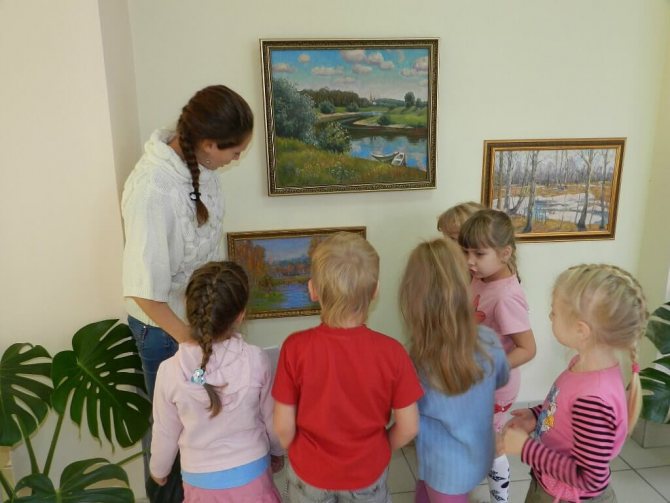
Visual methods (looking at a picture, listening to a piece of music together) suggest the emotional content of the moment. An acquaintance with objects of art should make a vivid impression on the child so that it is remembered.
The form of organization is as follows:
- when adults show an example of an action, they invite the child to repeat a poem or sing a song;
- Teachers invite the child to independently determine how to complete the task: sculpt, cut, or draw something.
It must be remembered that the aesthetic education of preschoolers is somewhat different from the methods of working with school-age children. For children, the emphasis is placed on visual perception; they are gradually brought to realize the importance of cleanliness and order. Older children are able to express their creativity. Preschoolers learn to evaluate, and schoolchildren are already creating a product and have a creative approach in the process of creating an object.
Methods of aesthetic education
The main methods that promote the development of children’s aesthetic senses, the ability to evaluate, and creatively apply acquired knowledge and skills include:
- Method of persuasion. It is used only when the phenomenon being studied is beautiful. Pupils have an emotional response when meeting works of art and participating in a holiday. The method can be considered equally verbal, because Children's observations receive commentary from an adult and awaken thoughts and feelings.
The teacher must select the most impressive works of art and take care of the appropriate mental mood of the children. The subject must be well mastered by the teacher, and the speech must be precise and expressive. When attention is focused on the beautiful, the teacher gives the concept of what is good and what is bad.
- Training method. It implies a practical action, an exercise aimed at changing the environment, instilling socially accepted cultural behavior skills. The content of the method is to teach the child to see and appreciate beauty, and to act accordingly.
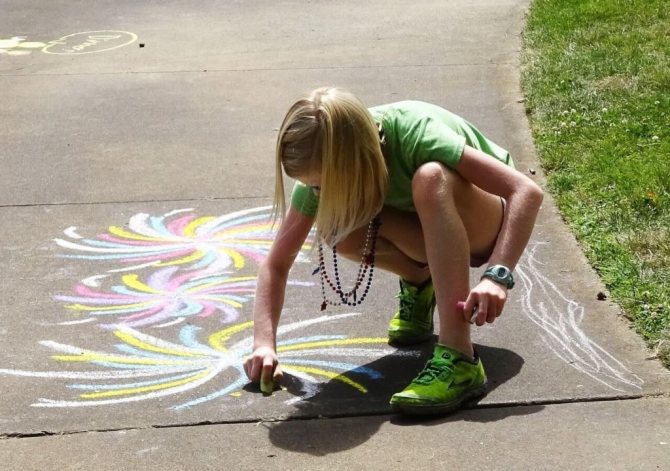
Systematic exercises and children's artistic practice promote children's activity.
- Method of problem situations. Allows creativity and the desire to act to awaken. The teacher invites the students to find a way to realize their artistic idea themselves. For example, after listening to a fairy tale, children are asked to portray one of the characters. The task can be simple or complicated by the poor choice of the hero. The child learns to think on his own, comes to an independent decision on how best to realize his plans: draw, sculpt, compose a poem.
- Encouraging empathy. A sympathetic person who knows how to empathize and compassion experiences joy from communicating with people, and celebrates successes and victories with them. Children who can sympathize are more open and friendly, they have more friends, and they are less likely to find themselves in conflict situations.
Emotional reading of fairy tales, discussion of illustrations, a puppet show or a musical number will help here.
Traditional methods of influencing students
Story. It should be emotional, have a plot outline, be educational, influence the imagination, but not interfere with self-assessment.
Lecture. Dedicated to more complex topics, it is appropriate for classes with older children. Equipping the lesson with visual material will give greater imagery. It is permissible to raise problematic topics, push students into discussion, and persuade them to express their point of view.
Conversation. This is not a teacher’s monologue in front of children, but a mutual emotional exchange of opinions. During the conversation, the teacher uses visual material, interprets scientific concepts, emphasizes certain beautiful characteristics in works of art, work, real and fictional characters in literature, theater, and cinema.
Dispute. Designed to discover and bring together different points of view, raise a problem, and attract children to discuss it. The task of adults is to carry out serious preparatory work to help identify positions, stimulate dialogue, and direct the dispute into a cultural direction.
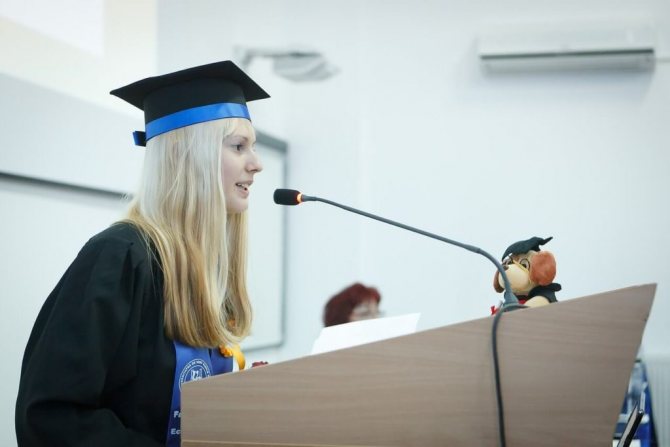
Aesthetics of everyday life
It is important to awaken in students the desire to affirm beauty wherever they spend their time, do business or relax, to involve them in creating an aesthetic environment around them. Only after this is it possible to use various means of aesthetic education. The environment in which a child lives and develops plays an important role in the development of aesthetic feelings. If the environment is aesthetic, beautiful, if there are beautiful relationships between people, the speech that the child hears is correct and pure, then he will accept the aesthetic environment as the norm and strive for it. Therefore, it is important to pay attention to the aesthetics of everyday life. The aesthetics of everyday life also includes a person’s appearance. The aesthetics of everyday life is the background that reinforces or destroys emerging ideas about beauty.
Means and methods of aesthetic education of children in kindergarten
Korotkova Svetlana
Means and methods of aesthetic education of children in kindergarten
Means and methods of aesthetic education of children in kindergarten.
The basis of the process of aesthetic education is the joint activity of the teacher and the child, aimed at developing his abilities to perceive beauty , artistic values and productive activity. General issues of aesthetic education of children include : an organized environment in which a child grows up and is brought up , the use of works of art (reproductions of paintings, prints, sculptures, etc.) in the design of the premises of a preschool institution, involving children in artistic activities, taking into account the interests and inclinations of children .
The means of aesthetic education of children objects and phenomena of the surrounding reality selected by the teacher and specially organized for the upbringing of children
1. Aesthetics of everyday life.
It is designed to teach a child to feel and understand the beauty of life, to cultivate in him the desire to create and preserve it. The artistic design of a preschool institution is determined by the content of educational work , the requirements for protecting life and promoting health, and its artistic development. Cleanliness and order are not only hygienic, but also aesthetic requirements for the interior of a kindergarten . It is important that the design be stylistically consistent. by children , parents, and teachers to decorate the premises . the kindergarten playground must also meet the appropriate hygienic and aesthetic .
2. Works of art.
They are used in the design of everyday life, during training, and independent activities. For this purpose, works of everyday and fairy-tale painting are selected (portraits, still lifes, landscapes, graphics (prints, engravings, book illustrations, small forms of sculpture (products made of earthenware, plaster, wood, works of decorative and applied art (ceramics, art glass, folk decorative and etc.)
.
Various activities in kindergarten are necessarily accompanied by music (morning exercises, leisure activities, etc.)
.
3. Nature.
Growing up among nature , a child learns to see the harmony, beauty, richness of colors of each season, to reproduce his impressions in oral stories, drawings, etc. All this is accompanied by the teacher’s stories that nature is a powerful and perfect creator of beauty, painters draw inspiration from it , composers, writers, the use of their works (for example, “Seasons”
P. Tchaikovsky, reproductions of paintings by I. Shishkin, etc.).
Excursions to nature are effective, because the impressions a child experiences in preschool leave an imprint for life. It is important for the teacher to choose words to accompany observation that would meet the objectives of aesthetic education .
4. Special training.
The formation of ideas about beauty, skills in artistic and creative activity, the development of aesthetic assessments , experiences and tastes is facilitated by special training for preschoolers in kindergarten . To do this, they use various types of activities, artistic and didactic games, holidays, matinees, excursions, walks, watching movies and TV shows, performances, etc.
5. Independent artistic activity of children .
It is an important means of aesthetic education for preschool children . In the process of artistic activity, they realize their creative ideas, inclinations, which can subsequently develop into the ability for artistic creativity.
The development of independent artistic activity is stimulated by the following factors:
— the learning process in the classroom, its developmental nature, the formation of methods of independent action;
- artistic impressions of children , encouraging them to further implement them in activities;
- pedagogically appropriate aesthetic subject environment ;
- the encouraging influence of parents who stimulate the creative searches and attempts of children ;
- indirect influence of the teacher who initiates the independent search of children .
To develop independent artistic activity in the group, special zones (centers)
with the necessary equipment and materials that children can freely use.
At the same time, the teacher takes care of the variety of children’s , the combination of various types of artistic activities: visual, artistic and speech, theatrical and playful, musical.
6. Holidays.
They are associated with children's vivid aesthetic experiences and the desire to test themselves in different genres of art. Preparation for the holiday, the participation of children in the creation of its program, the conditions for holding it, and the anticipation of the festive action form a special pre-holiday collective mood. of children are often involved in the preparation and celebration , which gives them emotional warmth.
Interesting plans of a teacher for organizing the aesthetic education of preschoolers can achieve their goals by correctly selecting and combining his methods , which are classified according to various criteria:
- according to the main pedagogical goal.
These methods include : persuasion; exercises in practical actions aimed at transforming the environment ; problematic situations that encourage creative and practical action; incentives for empathy, an emotionally positive response to the beautiful, a negative attitude towards the ugly;
- in general and special areas.
This group includes general pedagogical and special methods , the selection of which depends on the type of art that the teacher seeks to introduce children ;
— methods of teaching artistic activity.
Among them are visual (sample, demonstration of techniques for performing actions, verbal (conversations, instructions, instructions, advice, assessment and self-assessment of the results of children’s );
— methods children’s artistic and creative abilities .
They are based on developing in children the ability to act when solving problem-search tasks in non-standard situations.
Researchers suggest using game-based teaching techniques, game situations, and acting out children’s works in the classroom the aesthetic education , which creates a positive emotional atmosphere, promotes effective mastery of fine arts and abilities, improves the quality of work and promotes the development of interest in fine arts. It is especially important to ensure a combination of various types of activities in the development of artistic skills of preschoolers.
Since in preschool age a child is primarily inclined to play, it is necessary to widely use a variety of gaming techniques in order to develop his creativity:
- game situations that help develop cognitive and creative activity;
- songs, riddles, poems, fairy tales, musical works;
- demonstration of episodes of puppet performances that focus attention , evoke positive emotions, interest in what is being depicted, deepen aesthetic pleasure , but do not affect the results of the work;
- stories - drawing with fairy tale elements; search situations; imaginary situations.
Children who have identified certain skills and interests in artistic and visual activities form a contingent of preschool institutions of artistic and aesthetic direction , in which, under the guidance of teachers with an artistic education, clubs, studios, and creative workshops function. Children are invited to participate in them , according to their inclinations and interests. Artistic activity creates serious opportunities for the manifestation of a child’s individuality, therefore, his knowledge and the development of artistic abilities are the primary condition for the child to understand himself as a person endowed with creative potential, to cultivate responsibility for his talent, as a gift from God, to strive, overcoming tough tests, to uniquely realize his talent. The history of world culture knows many examples when a child began to realize all this at an early age. Therefore, every teacher should proceed from the fact that, perhaps, his students harbor such dreams.
Aesthetic development is associated with the formation of all facets of personality. In preschool age, the foundations of needs and tastes are formed, a love of art is born, and creative abilities, which every child is endowed with to varying degrees, manifest themselves. To implement them, it is necessary to have properly organized education and training , which takes into account the characteristics of the age and individuality of the child.
MAGAZINE Preschooler.RF
Integrated use of various means and methods of aesthetic education in the system of preschool educational organizationMigaleva Marina Vladimirovna, teacher of MBDOU DS No. 72 “Watercolor”, Stary Oskol, Belgorod region
The concept of aesthetic education is organically connected with the term aesthetics. Aesthetics (from the Greek aisthetiris - sentient, related to sensory perception) is the science of the most general laws of aesthetic, including artistic, human mastery of reality [11].
The history of aesthetics begins with Ancient Greece. In ancient Greek philosophers we find many interesting opinions about beauty and art. One of the first to try to define beauty was Pythagoras. In his judgments about aesthetics, he remained a mathematician and tried to calculate and measure beauty. Heraclitus sees harmony at the basis of beauty, but believes that beauty cannot be reduced to the base laws of numerical relations, as was the case with Pythagoras. Other researchers consider either character or social reality to be the main factor in aesthetic education.
Let's consider the concept of aesthetic education in the works of teachers
Author Definition
Aristotle Beauty is the property of objects, things, and phenomena themselves. He considers integrity, unity, proportionality, and correspondence of form and content mandatory for works of art.
- L. S. Vygotsky Aesthetic education depends on the specifics of age development and is completely determined by it.
- Yu. K. Babansky Aesthetic education is a process of joint activity of teachers and students, aimed at developing the aesthetic culture of preschoolers.
- V. N. Shatskaya Aesthetic education is the purposeful formation in a person of his aesthetic attitude to reality.
- A. Ilyinov Aesthetic education is the process of purposefully developing in a person the ability to understand and appreciate the beautiful and comic, to feel and experience the tragic, to create beauty in all spheres of life.
Author's opinion Aesthetic education is one of the areas of pedagogy, the main goal of which is to teach a person to understand and appreciate beauty.
There are many definitions of the concept of “aesthetic education”, but having considered only a few of them, it is already possible to identify the main provisions that speak about its essence.
Firstly, this is a process of targeted influence. Secondly, it is the formation of the ability to perceive and see beauty in art and life, and appreciate it. Thirdly, the task of aesthetic education is the formation of aesthetic tastes and ideals of the individual. Fourthly, the development of the ability for independent creativity and creation of beauty.
A variety of creative activities for children contribute to the development of their thinking and imagination, will, perseverance, organization, and discipline. The goal of aesthetic education was most successfully reflected by M. M. Rukavitsyn, who believes: “The ultimate goal (of aesthetic education) is a harmonious personality, a comprehensively developed person... educated, progressive, highly moral, with the ability to work, the desire to create, who understands the beauty of life and the beauty of art.” [18; 142 pp.]
Thus, having studied the many definitions of “aesthetic education”, one cannot but agree with the words of the Russian playwright A.P. Chekhov: “Everything in a person should be beautiful: face, clothes, soul, and thoughts . [20, 256 pp.]
According to scientists, nature is a powerful means of aesthetic education.
It is in it that you can see harmony - the basis of beauty: a variety of colors, shapes, sounds in their combination. Nature itself is a condition for the comprehensive education and development of a child. It becomes a means when an adult purposefully uses its “educational potential” and makes it visible to the child.
The teacher reveals the natural world to children and helps them see it. You just need to see this beauty for yourself and find words that are accessible to the heart of a child. Works of art about nature will provide him with invaluable help in this, which he must know well and skillfully use. In education using the means of nature, it is necessary not only a passive contemplative, but also an effective principle (to protect nature, to help it).
Social life, the work of people with whom the child constantly encounters, is also an important means of aesthetic education. The well-coordinated work of builders makes children want to create a good building, act together, and be attentive to each other. Excursions, when properly prepared and conducted, broaden the horizons of preschoolers, teach them to see, compare, generalize, which forms the basis for the development of creative imagination and abilities. [20]
A multifaceted and inexhaustible means of aesthetic education is art: fine art, music, literature, architecture, theater, cinema. The early introduction of children to real high art contributes to the emergence in the child’s soul of a truly aesthetic perception of reality. Each type of art reflects life in its own way and has its own special impact on the child’s mind and feelings.
From the first years of life, children are accompanied by oral folk art and children's literature. A fairy tale occupies a special place in their lives.
Another means of aesthetic education is the artistic activity of preschoolers, both organized by the teacher and independent. Fine art is necessary for a child. It gives him rich visual images.
In artistic activity, as a rule, there is a reproducing (reproductive) factor and a creative one. Both are necessary and interconnected - a child cannot create without learning to reproduce.
All of the above-mentioned means of aesthetic education - everyday life, nature, art, activity - are effective both on their own and in conjunction, but oversaturation is just as harmful to development as a lack of emotional impact. We must search and find the golden mean.
Having studied the most effective means of aesthetic education in a preschool educational organization, we will move on to studying the methods of aesthetic education.
A method is a way to achieve a goal, a way to solve problems [2].
Methods of aesthetic education are very diverse. They depend on many conditions: the volume and quality of artistic information, forms of organization and types of activities, and the age of the child. The level of training, skill and abilities of the teacher play a significant role. [19]
A child receives aesthetic information through many channels (social environment, objective world, natural phenomena, works of art). That is why the method of holistic perception of the plot of a painting, a fairy tale, or the musical and figurative construction of a piano piece is so important. To help the child listen to sounds, look at the colors and shapes of an object, the teacher directs his attention to more detailed perception and targeted observation. Based on how children receive aesthetic information (they get acquainted directly with a work of art, listening to a musical play, a song, a fairy tale, looking at paintings, or through a teacher who tells, explains, asks questions), methods of aesthetic education can be divided into visual and verbal. The performance of literary and musical works must be artistically expressive and emotional, otherwise the encounter with art will not have its impact. In the verbal method, it is also necessary to achieve vivid imagery so that children understand not only the content of a picture, poem, song or the meaning of the task, but also experience the mood corresponding to the mood of the characters [2].
Methods also change depending on the forms of organization of activities. During art classes, the teacher gives precise instructions, shows or invites children to find performance techniques themselves. An example would be learning poems or songs, which will require preliminary performance by an adult, a conversation about the artistic qualities that express the content and mood of the work, the use of visual aids, repeated performance of the text by children, and so on. In practice, methods are used to develop observation skills, independent actions, planning one’s activities and implementing plans. Depending on the age, level of preparedness, growth of individual needs and aspirations of the children, the methods become more complicated.
Pedagogical science and practice determine a number of the most effective methods that contribute to the formation of children’s aesthetic feelings, attitudes, judgments, evaluations, and practical actions: - the method of persuasion, aimed at developing aesthetic perception, appreciation, and initial manifestations of taste;
- training method, exercises in practical actions designed to transform the environment and develop skills of a culture of behavior
- method of problem situations that encourage creative and practical action
- a method of inducing empathy, emotionally positive responsiveness to the beautiful and a negative attitude towards the ugly in the world around us [2].
Consolidating acquired skills with practical actions allows you to bridge the gap between word and deed in the behavior of a child, who can say good words about the environment, but act contrary to them. Aesthetic experiences are always associated with ethical manifestations.
Thus, the means and methods of aesthetic education we are considering in a preschool educational organization help to awaken in children a sense of beauty, a desire to act according to their own, childish, but laws of beauty. At the present stage, these means and methods are effective and contribute to the formation of aesthetic feelings, attitudes, judgments, assessments, and practical actions in children.
In general, only a set of methods and means can provide a complete aesthetic education of a child.
List of used literature
- Azarov Yu.P. The art of education. M.: Education, 1985. -127 p.
- Alekseeva M.M., Yashina V.I. Speech development of a preschooler. M., 1998. -242 p.
- Amonashvili Sh.A. Reflections on humane pedagogy. M., 1996
- Bolotina L.R., Baranov S.P., Komarova T.S. Preschool pedagogy: Uch. allowance for higher education uch. head 2nd ed., rev. and additional M.: Academician. project, 2005. -240 p.
- Varkki N. A child in the world of creativity: Creative and aesthetic education of preschool children / N. Varkki // Preschool education. – 2003. – No. 6. — P.57-67.
- Borev Yu.B. Aesthetics. M.: Rus-Olympus: AST: Astrel, 2005. -829 p.
- Vygotsky L.S. Selected psychological studies. M., 1980. -384 p.
- Vygotsky L.S. Imagination and creativity in childhood. – M.: Pedagogy, 1991.
- Gavrilovets K.V., Kazimirskaya I.I. Moral and aesthetic education of preschool children: Book. for the teacher. 2nd ed., add. and processed Mn.: Nar. Asveta, 1985. –128 p.
- Dzhidaryan I.A. Aesthetic need / I.A. Dzhidarian. – M.: Nauka, 1986. -191 p.
- Doronova T.N. Development of children from 4 to 7 years old in theatrical activities // Child in kindergarten. – 2001. – No. 2.
- Zaporozhets I.D. Education of emotions and feelings in a preschooler. M., 1985. -186 p.
- Dramatization games // Emotional development of a preschooler / Ed. HELL. Koshelevoy. – M., 1983. – 76 p.
- Kazakova T.G. Develop creativity in preschoolers. A manual for children's educators. garden / T.G. Kazakova. - M.: Education, 1995.
- Krasny Yu. ABC of feelings: Program for the comprehensive aesthetic development of preschoolers / Yu. Krasny // Art at school. -2003. -No. 6. — p.17-29.
- Likhachev B.T. Methodological foundations of pedagogy / B.T. Likhachev. – Samara: Bakhrakh, 1998.
- Likhachev D.B. Theory of aesthetic education of preschool children.
- Melik-Pashaev A.A., Novlyanskaya Z.N. Steps to creativity / A.A. Melik-Pashaev, Z.N. Novlyanskaya. – St. Petersburg: Peter, 1997.
- Nadezhdin N.I. Works: In 2 volumes. T.1: Aesthetics / N.I. Nadezhdin / Ed. BEHIND. Kamensky. – St. Petersburg: Peter, 2000.
- Obukhova L.G. Psychology of childhood. M., 1992. -263 p.
| Next > |
